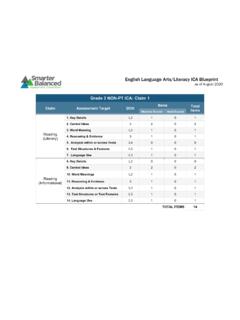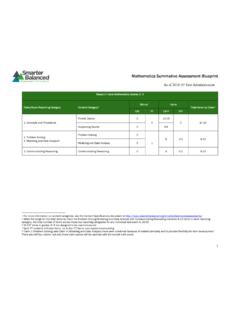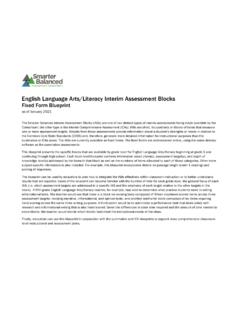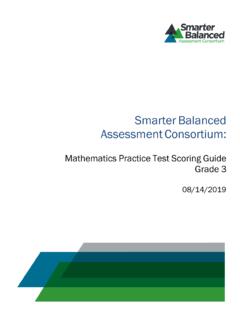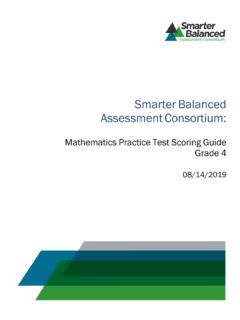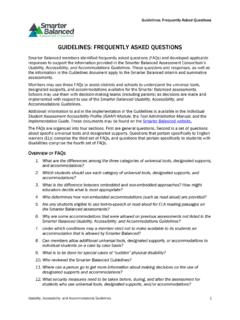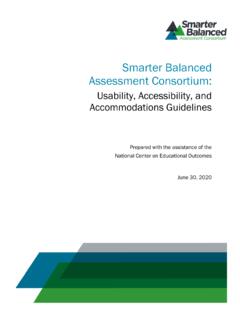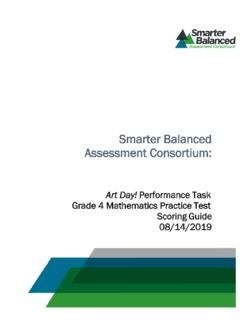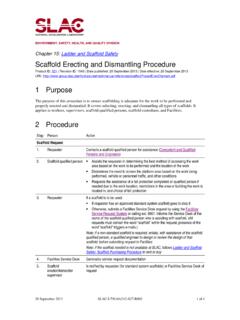Transcription of Initial Achievement Level Descriptors Glossary
1 Initial Achievement Level Descriptors Glossary Academic Words Words that are used in diverse disciplines and appear in all types of texts (See , page 33) Context Real-world application that provides the frame for items or tasks measuring mathematical skills and processes Familiar Context Problems, situations, or constructs that are commonly introduced or used during instruction or exercises in a classroom setting Fluency The ability to perform appropriate procedures efficiently and accurately Model A representation or an example ( , equation, expression, drawing, diagram, tables, graph, or chart) Rhetorical Features Devices that are used to manipulate language for desired effects upon readers ( , advocate, inform, or create suspense) Rigor With regard to assessment, the degree of challenge an item or a task presents. Rigor can contribute to, but is not the same as, difficulty. Within a set of items, there can be a range of rigor and levels of complexity.
2 Contributing factors to an item s or a task s rigor are the degree of evidence relative to the expectations of the constructs (standards) being measured, the number of constructs being assessed, and the cognitive management the item or task requires of the student ( , the number of parts or pieces within a task). Scaffolding Support for students within the context of an assessment item or task ( , leading questions, incomplete charts or graphs, or delimited text). There may be degrees of scaffolding within items; for example, highly scaffolded tasks may guide students through a series of short steps, which will build students understanding and help them complete the task. Support (use of) A means for guiding or directing students through an item or a task, similar to scaffolding. The support referenced in the Common Core State Standards for English Language Arts (CCSS)(ELA) may include direct verbal support or guidance from a parent or teacher.
3 In an assessment item or task, support may be provided in the way the item/task is presented to the student. For example, a list of suggestions ( , Be sure to ..) may be offered to students, or students may be pointed to a specific part of a text to find the answer. Initial Achievement Level Descriptors Glossary Technology The practical application of knowledge, especially in a particular area ( , medical technology); a capability given by the practical application of knowledge ( , a car's fuel-saving technology); a manner of accomplishing a task, especially using technical processes, methods, or knowledge ( , new technologies for information storage) ( ) Text Complexity and levels The degree of reading challenge of texts. As students develop critical reading skills, the complexity of the texts they read will increase. Text complexity is determined by qualitative measures ( , meaning/ purpose, text structure, language features, or knowledge demands) and quantitative measures ( , Lexiles).
4 Using professional judgment and giving consideration to the reader/task demands are also part of the process for evaluating text complexity. Within any assessment, there will be a range of complexity among the texts. For the Achievement Level Descriptors , text complexity levels are designated as low, moderate, moderate-to-high, and unusually high. This is a reflection of the CCSS, indicating that the main driver of rigor and progress in ELA is the students ability to read and comprehend increasingly complex texts; determining a main idea is a consistent, demonstrable skill, but the ideas and texts become more complex and abstract with deeper levels of meaning across grades. (See , pages 2-16 and resource listed on page 3 of this Glossary ) Tiers One, Two, and Three levels that rank words in terms of their commonality and applicability. All three levels are vital to vocabulary development, communication, and comprehension. Tier One words are those of everyday speech, usually those learned in early grades.
5 Tier Two words are referred to in the CCSS as general academic words and are those words that appear across many types of written texts more frequently than in speech; these words are highly generalizable. Tier Three words are words specific to a domain or field of study. (See , pages 33-35) Unfamiliar Context Problems, situations, or constructs that are not typically introduced or used during instruction or exercises in a classroom setting Initial Achievement Level Descriptors Glossary Resources Hess, K. & Biggam, S. (2004). A Discussion of Increasing Text Complexity. An article produced in partnership with the New Hampshire, Rhode Island, and Vermont Departments of Education.
